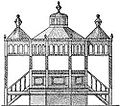Category:Bimot
Jump to navigation
Jump to search
elevated platform for speakers | |||||
| Upload media | |||||
| Subclass of | |||||
|---|---|---|---|---|---|
| Different from | |||||
| Partially coincident with | |||||
| |||||
Bosanski: Bima, također: Bimah, poljski: Bimot, od grčke riječi Βήμα, Bema, Također Almemor, je centralno mjesto u sinagogi na kojem se čita iz Tore za vrijeme bogosluženja.
Čeština: Bima je vyvýšené místo v synagoze, nacházející se většinou uprostřed hlavního sálu modlitebny. Bima (z řeckého βῆμα) - „pódium“, používá se pro ni též označení almemor (אלממור) nebo teva (תבה) mezi sefardskými židy.
Deutsch: Die Bima, auch: Bimah, pl.: Bimot, von griechisch Βήμα, Bema, oder auch Almemor genannt, ist der Platz in einer Synagoge, von dem aus die Tora während des Gottesdienstes verlesen wird. Bima und Toraschrein bilden dabei die liturgisch-funktionalen Zentren im Gottesdienst.
English: A bimah (among Ashkenazim, derived from Greek ), almemar (from Arabic al-minbar) or tebah (among Sephardim) is the elevated area or platform in a Jewish synagogue which is intended to serve the place where the person reading aloud from the Torah stands during the Torah reading service. The bimah is sometimes misdescribed as an altar or tower. The bimah was located in the centre of the synagogue most likely just as the temporary wooden bimah (this is the origin of the term) was central to the "women's courtyard" of the Temple in Jerusalem during the Hakhel ceremony. While the original meaning of the word referred to the platform, the table from which the Torah scroll is read can also be referred to as the bimah, even when it is not on a platform. This later became a sign of the Orthodox synagogue in the mid-nineteenth century. The Reform (Neolog) temples moved the bimah to the front of the temple facing the congregation. One of the well-known decrees of the Chatam Sofer was that the bimah must remain in the centre of an Orthodox synagogue.
Français : La bimah ( hébreu בימה), almemor ou tevah (héb. תיבה) est l'estrade où se lit la Torah et où est célébrée la liturgie.
Ελληνικά: Το Iερό Βήμα καταλαμβάνει το ανατολικό άκρο του ναού. Ονομάζεται έτσι διότι βρίσκεται υψηλότερα από τον υπόλοιπο ναό, κατ' επίδραση των ρωμαϊκών βασιλικών, οι οποίες ήταν υπερυψωμένες στο σημείο αυτό, από όπου ομιλούσαν οι ρήτορες των δικαστηρίων. Θεωρείται χώρος ιερός, επειδή εκεί τελούνται τα ιερά μυστήρια, με κορυφαίο το μυστήριο της Θείας Ευχαριστίας. Επιτρέπεται η είσοδος μόνο των κληρικών και γι' αυτό ονομάζονταν άδυτον και άβατον. Στους βυζαντινούς χρόνους, στον μόνο λαϊκό, στον οποίο επιτρέπονταν ή είσοδος ήταν ο αυτοκράτορας, διότι θεωρούνταν ιερό πρόσωπο (Σωζομενού Εκκλ. Ιστ. Ζ΄25).
Русский: Вима ( — трибуна) или иератион — часть храма:
Українська: Біма (у східній Європі; також Алмемар, Алмемор, перекручене арабське слово «аль-мінбар», кафедра, пюпітр) — підвищене місце в синагогах, на якому розміщується кафедра для читання П'ятикнижжя і Пророків.
Subcategories
This category has the following 14 subcategories, out of 14 total.
A
B
- Bimot in England (1 F)
C
F
- Bimot in France (13 F)
G
- Bimot in Germany (8 F)
H
- Bimot in Hungary (6 F)
I
- Bimot in India (2 F)
- Bimot in Israel (27 F)
- Bimot in Italy (9 F)
L
- Bimot in Latvia (4 F)
N
- Bimot in the Netherlands (11 F)
P
S
- Bimot in Singapore (6 F)
Media in category "Bimot"
The following 30 files are in this category, out of 30 total.
-
13 Synagogue Or Torah -La salle de prière.JPG 1,944 × 2,592; 2.05 MB
-
Beith Juda - Synagoge Innenraum.jpg 2,560 × 1,920; 1.6 MB
-
Bema2021.svg 512 × 362; 207 KB
-
BialyBimah.JPG 3,264 × 2,448; 2.22 MB
-
Brockhaus and Efron Jewish Encyclopedia e1 957-0.jpg 1,077 × 829; 287 KB
-
Brockhaus and Efron Jewish Encyclopedia e1 959-1.jpg 519 × 592; 83 KB
-
Exeter Synagogue JohnWhite.JPG 2,304 × 3,072; 3.39 MB
-
ExeterSynagogue JW.png 250 × 333; 187 KB
-
Israel Museum Synagogue of Aleppo 06.jpg 435 × 574; 68 KB
-
Istanbul asv2021-11 img03 Hemdat Israel Synagogue.jpg 7,719 × 5,146; 18.7 MB
-
Istanbul asv2021-11 img07 Hemdat Israel Synagogue.jpg 4,902 × 7,353; 14.86 MB
-
Janow IS PAN 0000018691 fot Sz Zajczyk p 1939.png 1,401 × 2,048; 3.47 MB
-
Maputo Synagogue Interior.jpg 1,953 × 2,113; 1,012 KB
-
Middle Street Synagogue, Brighton (May 2013) - Bimah.jpg 1,800 × 2,592; 886 KB
-
Museum of the History of Polish Jews in Warsaw Main exhibition Gwoździec synagogue.jpg 2,953 × 2,353; 2.79 MB
-
Spanishhaggadah.jpg 296 × 360; 41 KB
-
Synagogue Aleppo postcard colorized.png 1,862 × 1,186; 3.88 MB
-
Synagogue La Ghriba de Djerba (8480820859).jpg 4,288 × 2,848; 6.32 MB
-
The Great Synagogue in Sydney, bimah.JPG 2,736 × 3,648; 1.72 MB
-
Trnava Orthodoxe Synagoge Bima 672.jpg 3,264 × 4,896; 10.09 MB
-
Trnava Orthodoxe Synagoge Bima 673.jpg 4,896 × 3,264; 10.05 MB
-
V01p430001 Almemar.jpg 511 × 398; 106 KB
-
V01p431001 Almemar.jpg 244 × 286; 16 KB
-
V01p431004 Almemar.jpg 250 × 220; 15 KB
-
V10p267001 Pulpit.jpg 326 × 380; 30 KB
-
V11p626001 Synagogue.jpg 323 × 241; 33 KB
-
Бима Воронежской синагоги.jpg 1,024 × 678; 261 KB
-
Бима, подиум Бимы.jpg 1,024 × 753; 379 KB






























